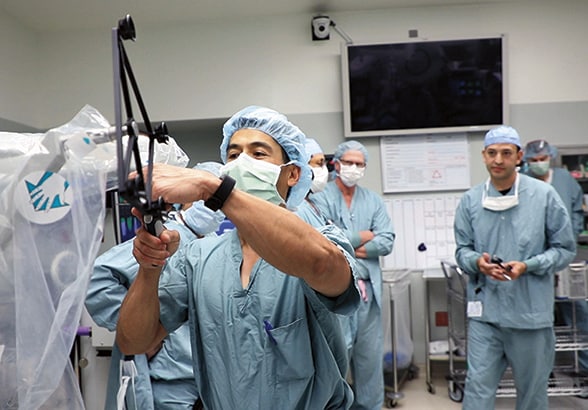March 20, 2018
 Preparation for robotic-arm-assisted technology
Preparation for robotic-arm-assisted technology
Cedric J. Ortiguera, M.D., prepares to use robotic-arm-assisted technology to perform full knee replacement.
Mayo Clinic in Jacksonville, Florida, is offering full knee replacement using robotic-arm-assisted technology. Although the procedure has been performed for less than a year, the preliminary results are encouraging.
"Patients who have had a knee replacement with both the robot and traditional surgery feel that it's been easier to recover from the robotic procedure early on, and to regain the knee's range of motion," says Cedric J. Ortiguera, M.D., a consultant in Orthopedic Surgery at Mayo Clinic's Florida campus. "We're hopeful that this procedure is an advance that will help patients. But it will take time to prove that the added costs of the robotics will prove to be worthwhile for long-term outcomes for the patients."
The procedure is similar to robot-assisted partial knee replacement, which has been available for about a decade. The first step is assessment to determine whether the patient is a candidate for full knee replacement. "There are no contraindications for the robot-assisted technology. Anyone who qualifies for a knee replacement can generally have a robotic knee replacement," Dr. Ortiguera says.
A CT scan of the patient's knee is then used to generate a 3-D computer model of the bone. "Looking at that model of the patient's own bone allows us to plan the size and position of the implant before surgery," Dr. Ortiguera says. "During the actual surgery, we're able to take some fine-tuning measurements and make final adjustments to the surgery plan."
When preparing the patient's bone for the implant, the surgeon guides the robotic arm within the area of the preoperative surgical plan, increasing the accuracy of bone preparation. Working with precise measurements based on the patient's individual anatomy allows the Mayo Clinic orthopedic surgeon to more accurately balance the ligaments and soft tissue around the knee replacement.
"Achieving that accurate balance is a challenge," Dr. Ortiguera says. "The robotic device gives us much more information during the surgery to find that balance and to determine how loose or tight the implant might be on a single side."
Historically, patient satisfaction with the outcome of knee replacement has lagged behind satisfaction with hip replacement. "One of the reasons patients may not be happy with their knee replacements may be the difficulty in balancing the soft tissues that support the implant for that particular patient," Dr. Ortiguera says.
About 800,000 full knee replacements are performed in the United States each year — a number projected to rise to 3 million by 2030. "People are not just living longer; they're staying healthier longer. They want to stay active and not accept the limitations of arthritis," Dr. Ortiguera says. "Patients as well as orthopedic surgeons are looking for improved knee surgery."